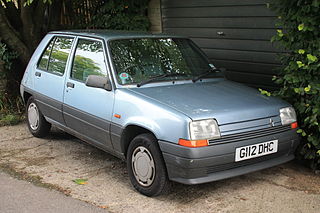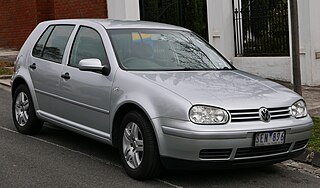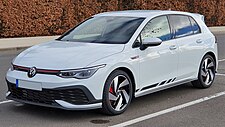
The Volkswagen Polo is a supermini car (B-segment) produced by the German car manufacturer Volkswagen since 1975. It is sold in Europe and other markets worldwide in hatchback, saloon, and estate variants throughout its production run. As of 2018, six separate generations of the Polo have been produced, usually identified by a "Series" or "Mark" number.

The Renault 5 is a five-passenger, three or five-door, front-engine, front-wheel drive hatchback supermini manufactured and marketed by the French automaker Renault over two generations: 1972–1985 and 1984–1996.

The Rover 200 Series, and later the Rover 25, are a series of small family cars that were produced by British manufacturer Rover from 1984 until 2005.

Fifth Gear is a British motoring television magazine series which has been broadcast since 2002. Originally shown on Channel 5 from 2002 to 2011, it began as a continuation of the original version of the BBC show Top Gear, which ran from 1977 until being cancelled in 2001. It moved to the Discovery Channel in 2012, then in 2015 to History; since 2018 it has been broadcast on Quest. The show is currently presented by Vicki Butler-Henderson and Jason Plato, with Rory Reid, Grace Webb and Jimmy de Ville featuring in some episodes. Its former presenters include Quentin Willson, Adrian Simpson, Jonny Smith, former racing driver Tiff Needell and Car SOS host Tim Shaw.

The Geneva International Motor Show was an annual auto show held in March in the Swiss city of Geneva.

The International Motor Show Germany or International Mobility Show Germany, in German known as the Internationale Automobil-Ausstellung, is one of the world's largest mobility trade fairs. It consists of two separate fairs, that subdivided in 1991. While the IAA Mobility displays passenger vehicles, motorcycles and bikes, the IAA Transportation specializes in commercial vehicles. Before the separation, the show was held solely at the Messe Frankfurt.

The Ford Escort is a small family car that was manufactured by Ford of Europe from 1968 until 2000. In total there were six generations, spread across three basic platforms: the original, rear-wheel-drive Mk.1/Mk.2 (1968–1980), the "Erika" front-wheel-drive Mk.3/Mk.4 (1980–1992), and the final CE-14 Mk.5/Mk.6 (1990–2002) version. Its successor, the Ford Focus, was released in 1998, but the final generation of Escort was phased out gradually, with the panel van version ending production in 2002 in favour of the Ford Transit Connect.

Evo is a British automobile magazine dedicated to performance cars, from hot hatches to supercars published by Carwow.

Sport compact is a United States marketing classification for a high-performance version of a compact or a subcompact car. There is no precise definition, and the description is applied to various models for promotional purposes.

The C-segment is the 3rd category of the European segments for passenger cars and is described as "medium cars". It is equivalent to the Euro NCAP "small family car" size class, and the compact car category in the United States.
1985 in motoring deals with developments in the automotive industry throughout the year by various automobile manufacturers, which are grouped by country. This includes the designs, developments, manufactures, markets, and sale of cars.

The Volkswagen Golf Mk5 is a compact car/small family car manufactured and marketed by Volkswagen, as the fifth generation of the Golf in three- or five-door hatchback and a five-door station wagon (2007–2009) configurations, as well as the successor to the Golf Mk4. Using the Volkswagen Group A5 (PQ35) platform, the Mk5 debuted at the Frankfurt Motor Show in October 2003 and went on sale in Europe for the 2004 model year. While marketed as the Volkswagen Rabbit in the United States and Canada, the GTI model in these countries was marketed simply as the Volkswagen GTI.

The Volkswagen Golf Mk4 is a compact car, the fourth generation of the Volkswagen Golf and the successor to the Volkswagen Golf Mk3. Launched in October 1997 for the 1998 model year, it was the best selling car in Europe in 2001.

The Volkswagen Golf Mk2 is a hatchback, the second generation of the Volkswagen Golf and the successor to the Volkswagen Golf Mk1. It was Volkswagen's highest volume seller from 1983 and ended in (German) production in late 1992, to be replaced by the Volkswagen Golf Mk3. The Mk2 was larger than the Mk1; its wheelbase grew slightly, as did exterior dimensions. Weight was up accordingly by about 120 kg (260 lb). Exterior design, developed in-house by VW design director Schäfer, kept the general lines of its Giugiaro-designed predecessor, but was slightly more rounded. All told, about 6.3 million second-generation Golfs were built.

The Volkswagen Golf Mk1 is the first generation of a small family car manufactured and marketed by Volkswagen. It was noteworthy for signalling Volkswagen's shift of its major car lines from rear-wheel drive and rear-mounted air-cooled engines to front-wheel drive with front-mounted, water-cooled engines that were often transversely-mounted.
2002 in motoring deals with developments in the automotive industry that occurred throughout the year 2002 by various automobile manufacturers, grouped by country.

The Peugeot 208 is a subcompact car produced by the French automaker Peugeot. Unveiled at the Geneva Motor Show in March 2012 and positioned below the larger 308, the 208 replaced the 207 in 2012, and is currently at its second generation.

The 2014 Paris Mondial de l'Automobile or 2014 Paris Motor Show took place from 4 October to 19 October 2014 on 'Automobile and Fashion' theme.

Volkswagen R is the brand used by the German auto manufacturer Volkswagen to indicate a sport or high performance model. An "R" badge is placed on the grille, front fenders and trunk of R-model vehicles to indicate the vehicle's trim level.
























